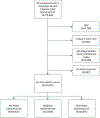Effect of a HEART Care Pathway on Chest Pain Management Within an Integrated Health System
- PMID: 30797573
- PMCID: PMC6650318
- DOI: 10.1016/j.annemergmed.2019.01.007
Effect of a HEART Care Pathway on Chest Pain Management Within an Integrated Health System
Abstract
Study objective: We describe the association of implementing a History, ECG, Age, Risk Factors, and Troponin (HEART) care pathway on use of hospital care and noninvasive stress testing, as well as 30-day patient outcomes in community emergency departments (EDs).
Methods: We performed a prospective interrupted-time-series study of adult encounters for patients evaluated for suspected acute coronary syndrome. The primary outcome was hospitalization or observation, noninvasive stress testing, or both within 30 days. The secondary outcome was 30-day all-cause mortality or acute myocardial infarction. A generalized estimating equation segmented logistic regression model was used to compare the odds of the primary outcome before and after HEART implementation. All models were adjusted for patient and facility characteristics and fit with physicians as a clustering variable.
Results: A total of 65,393 ED encounters (before, 30,522; after, 34,871) were included in the study. Overall, 33.5% (before, 35.5%; after, 31.8%) of ED chest pain encounters resulted in hospitalization or observation, noninvasive stress testing, or both. Primary adjusted results found a significant decrease in the primary outcome postimplementation (odds ratio 0.984; 95% confidence interval [CI] 0.974 to 0.995). This resulted in an absolute adjusted month-to-month decrease of 4.39% (95% CI 3.72% to 5.07%) after 12 months' follow-up, with a continued trend downward. There was no difference in 30-day mortality or myocardial infarction (0.6% [before] versus 0.6% [after]; odds ratio 1.02; 95% CI 0.97 to 1.08).
Conclusion: Implementation of a HEART pathway in the ED evaluation of patients with chest pain resulted in less inpatient care and noninvasive cardiac testing and was safe. Using HEART to risk stratify chest pain patients can improve the efficiency and quality of care.
Copyright © 2019 American College of Emergency Physicians. Published by Elsevier Inc. All rights reserved.
Conflict of interest statement
Figures




Comment in
-
Can a HEART Pathway Improve Safety and Diagnostic Efficiency for Patients With Chest Pain?Ann Emerg Med. 2019 Aug;74(2):181-184. doi: 10.1016/j.annemergmed.2019.02.030. Epub 2019 May 9. Ann Emerg Med. 2019. PMID: 31080033 No abstract available.
Similar articles
-
Evaluation of Outpatient Cardiac Stress Testing After Emergency Department Encounters for Suspected Acute Coronary Syndrome.Ann Emerg Med. 2019 Aug;74(2):216-223. doi: 10.1016/j.annemergmed.2019.01.027. Epub 2019 Apr 5. Ann Emerg Med. 2019. PMID: 30955986 Free PMC article.
-
Safely Identifying Emergency Department Patients With Acute Chest Pain for Early Discharge.Circulation. 2018 Nov 27;138(22):2456-2468. doi: 10.1161/CIRCULATIONAHA.118.036528. Circulation. 2018. PMID: 30571347 Free PMC article.
-
HEART Pathway Implementation Safely Reduces Hospitalizations at One Year in Patients With Acute Chest Pain.Ann Emerg Med. 2020 Nov;76(5):555-565. doi: 10.1016/j.annemergmed.2020.05.035. Epub 2020 Jul 28. Ann Emerg Med. 2020. PMID: 32736933 Free PMC article.
-
An end-user's guide to the HEART score and pathway.Am J Emerg Med. 2017 Sep;35(9):1350-1355. doi: 10.1016/j.ajem.2017.03.047. Epub 2017 Mar 21. Am J Emerg Med. 2017. PMID: 28363616 Review.
-
HEART Score Risk Stratification of Low-Risk Chest Pain Patients in the Emergency Department: A Systematic Review and Meta-Analysis.Ann Emerg Med. 2019 Aug;74(2):187-203. doi: 10.1016/j.annemergmed.2018.12.010. Epub 2019 Feb 2. Ann Emerg Med. 2019. PMID: 30718010
Cited by
-
Sensor Technologies to Manage the Physiological Traits of Chronic Pain: A Review.Sensors (Basel). 2020 Jan 8;20(2):365. doi: 10.3390/s20020365. Sensors (Basel). 2020. PMID: 31936420 Free PMC article. Review.
-
Identifying patients with symptoms suspicious for COVID-19 at elevated risk of adverse events: The COVAS score.Am J Emerg Med. 2021 Aug;46:489-494. doi: 10.1016/j.ajem.2020.10.068. Epub 2020 Nov 5. Am J Emerg Med. 2021. PMID: 33189516 Free PMC article.
-
Graded Coronary Risk Stratification for Emergency Department Patients With Chest Pain: A Controlled Cohort Study.J Am Heart Assoc. 2021 Nov 16;10(22):e022539. doi: 10.1161/JAHA.121.022539. Epub 2021 Nov 6. J Am Heart Assoc. 2021. PMID: 34743565 Free PMC article.
-
Impact of Physician-Patient Language Concordance on Patient Outcomes and Adherence to Clinical Chest Pain Recommendations.Acad Emerg Med. 2020 Jun;27(6):487-491. doi: 10.1111/acem.13940. Epub 2020 Mar 12. Acad Emerg Med. 2020. PMID: 32056327 Free PMC article.
-
Aspirin does not modify cardiovascular event risk in endometriosis in the California Teachers Study.Eur Heart J Open. 2025 May 14;5(3):oeaf023. doi: 10.1093/ehjopen/oeaf023. eCollection 2025 May. Eur Heart J Open. 2025. PMID: 40370503 Free PMC article.
References
-
- Prevention CfDCa. National Hospital Ambulatory Medical Care Survey: 2010 Emergency Department Summary Tables. 2010.
-
- Sabbatini AK, Nallamothu BK, Kocher KE. Reducing variation in hospital admissions from the emergency department for low-mortality conditions may produce savings. Health Aff (Millwood). 2014;33(9):1655–1663. - PubMed
Publication types
MeSH terms
Substances
Grants and funding
LinkOut - more resources
Full Text Sources
Medical

